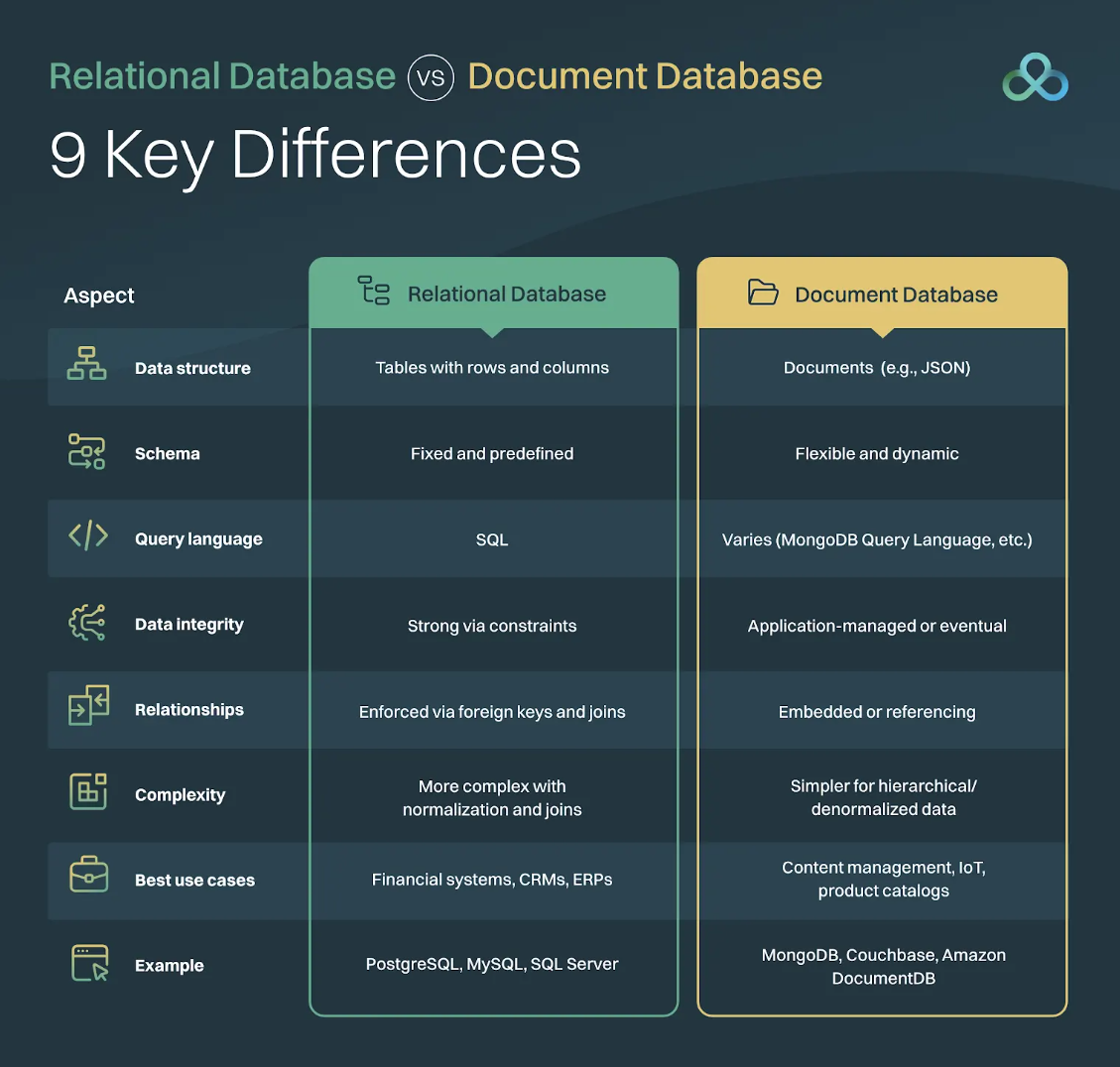Databases are the best way to store and fetch digital data, and there are two main types: relational and non-relational. A common example of a non-relational database is a document database. When planning a new workflow, choosing the right database is essential for long-term scalability. You’ll want to assess your structural needs and the type of project or use case to determine which database is the right choice.
In this guide, we’ll discuss both relational and document databases. By reading a brief overview of each and comparing them, you’ll be able to make an informed decision about which type to leverage for your next project.
What is a relational database?
A relational database organizes data in structured tables that use rows and columns to establish relationships between information. This type of database is managed by software called a relational database management system (RDBMS). Each row represents a specific record or entity, such as users or orders, while each column represents the attributes of those records, such as username or email.
There are four key characteristics that define a relational database:
- Tables: This is how data is stored in an RDBMS. Each table contains rows, or records, of related data. You may have a table named “Products” that stores information such as the description and price.
- Attributes: Every column in your table relates to a data attribute or descriptor, such as email, username, or created_at. In the “Products” table, attributes might include “color,” “style,” and so on.
- Primary key: Every table has a unique identifier or primary key. This non-null key ensures that each record within the table can be identified. For the “Products” table, the SKU number would be the primary key.
- Relationships: Relationships are unique to RDBMS. If the primary key of one table is used in another table, this corresponding column is known as the foreign key. One record in a table can be linked to multiple records in another table, but each record in the second table relates to only one record in the first. For example, one customer can place multiple orders, but each order number is associated with only one customer.
Structured Query Language (SQL) Is the standard language for querying data in a relational database. Developers write SQL queries to perform Create, Read, Update, and Delete (CRUD) operations.
For example, a small online retail business stores customer, product, and order information in separate tables within a relational database. The customers table contains customer details such as name and contact information, each with a unique customer ID as the primary key. The orders table stores order information with an order ID and includes the customer ID as a foreign key to link orders to customers. The products table contains product details with unique product IDs.
When employees need comprehensive order information, they can use SQL JOIN operations to combine data from multiple tables. For instance, they might join the orders table with the customers table to see which customer placed each order, or join with the products table to see what items were ordered. This separation of data into specialized tables keeps information organized while allowing flexible queries through relationships.
Advantages of relational databases
Relational databases offer high flexibility. They are commonly used in every industry for a range of applications and range from contact management systems to complex financial solutions to enterprise resource planning (ERP) systems. In these use cases, relational databases offer the following advantages:
- Structured data model: Relational databases utilize a highly organized table format to ensure predictability. This structure also makes it easy to determine the relationships between data and connect one table to another, preventing repetition or inaccuracy.
- Data integrity and relationships: RDBMS utilize constraints and foreign keys to connect related tables. This helps you make sure your information is complete and acts as a fail-safe to prevent inaccuracies and inconsistencies.
- Robust querying with SQL: Relational databases utilize SQL for queries and reporting. The English-like syntax of SQL makes it possible for any developer to efficiently search through data using robust filtering, powerful JOINS, etc.
- ACID compliance: Atomicity, consistency, isolation, and durability (ACID) standards guarantee reliable transactions. If one change fails, the whole transaction fails.
- Advanced security features: Database administrators can create several tables within a database. Each table can have its own access settings. These granular access controls and roles ensure that only relevant users can read or interact with confidential or restricted information.
- Maturity: RDBMSes have been around for years, meaning there is a well-established ecosystem of tools, resources, and best practices to help anyone understand and interact with them.
- Elimination of data redundancy: Through normalization, data is organized and stored while anomalous data is eliminated. When you don’t have to store or manage duplicate or incorrect data, you spend less on storage costs.
Challenges of relational databases
Despite the accessibility of relational databases and their ease of use, there are certain situations for which they are not ideal. Challenges include the following:
- Scalability concerns: Relational databases are not natively built for horizontal scaling because they exist on one server. However, they can scale vertically.
- Rigidity of schema: Relational databases use rigid schemas, such as defined columns and data types. While this makes data easy to interpret, it also makes it difficult to change the structure of how data is organized.
- Complexity with high-volume, varied data: A relational database organizes and stores diverse types of related information. This relationship makes an RDBMS less suited for unstructured or semi-structured data.
- Performance impact with JOINS: The number of tables in a database, the complexity of their schema, and the volume of data all influence how a database performs. As a relational database scales, its performance often decreases, especially with large datasets or complex queries.
- Learning curve: While RDBMSes follow well-understood principals, there is a learning curve. You must understand SQL and schema design to work effectively within a relational database.
What is a document database?
Document databases (NoSQLs) store data in documents, often in (JSON)-like or binary JSON (BSON)–like structures. These structures support a variety of data types, including strings, numbers, dates, arrays, objects, and nested documents. In a document database, the information is stored in a key value pair format.
A document database is designed to store, retrieve, and manage semi-structured data and documents. Like relational databases, these types of databases have distinguishing features, including:
- Documents: A document is a self-contained unit of data stored in an encoded form, such as JSON or BSON. Each document is inherently flexible because it has a unique structure and varying fields and contains all information related to a specific item.
- Collections: Collections are like tables in relational databases. However, each collection of data does not require a fixed schema, meaning documents within a collection can utilize different structures.
- Flexibility: Because document databases don’t have a strict schema, each document can vary. This flexibility makes it easy to adapt and change a document when your business needs evolve.
- Scalability: Document databases are built to scale horizontally and distribute data across multiple nodes. This scalability makes them suited for handling immense amounts of data and large-scale applications.
- Integrated data retrieval: In a document database, all relevant data lives within a single document. You can query data without using complex JOINS.
In a document database for an e-commerce site, for example, all information about a specific product would be included in a single document. This includes variations, such as varied sizes, prices, and colors. Documents are easier for people to read and understand because the data is organized and easy to view.
Advantages of document databases
Document databases are favored in situations with a fluid data model and in modern artificial intelligence (AI) applications. The scalability of these models and how easy they are to change are just a few of their benefits. This type of database is often used for e-commerce platforms, mobile applications, and content management systems because it offers the following advantages:
- Schema agility: Document databases don’t require a predefined schema, which makes them easy to adapt over time. You can add or modify fields within a single document without impacting other data.
- Horizontal scalability: Document databases are built for distributed architecture. This distribution of traffic and data storage across multiple nodes is more cost-effective and scalable.
- Unified data model: Document databases store diverse structures in one collection. This data handling reduces the need for complex JOINS and improves query performance in read-heavy workflows.
- Rapid development cycle: Document databases have fewer restrictions regarding schema and data types. With fewer constraints, developers can create databases quickly.
- Native support for modern data formats: NoSQL databases store data in modern data formats, such as JSON or XML. This native support makes these databases easy to integrate with web and mobile applications.
- Geographically distributed architecture: Because document databases distribute data across multiple servers, you can create geographically distributed architectures. This enables high availability, reduced latency, and faster disaster recovery.
- Cost efficiency at scale: Document databases scale horizontally and can be quickly created. This makes them more cost-efficient for large-scale applications than relational databases.
Challenges of document databases
Document databases help resolve the challenges of working with dynamic data because they offer a more flexible approach to data management and storage. However, they do have some drawbacks of their own, including:
- Consistency vs. availability: Document databases distribute data across multiple nodes. Sometimes the replication process is interrupted, which can cause temporary inconsistencies. However, this is a trade-off when ensuring that your data is always available.
- Data redundancy: In relational databases, normalization helps eliminate redundancy by dividing data into tables. Document databases lack native support for JOINS, so some duplication is common.
- Limited query capabilities: Document databases are not as powerful as SQL for some tasks. They often struggle with complex queries that involve joining data across multiple collections.
- Maturity and tooling: Compared to relational databases, there are fewer experts, resources, and tools available for document databases. While they are catching up to relational DBs, this lack of maturity can slow down debugging, optimization, and development.
- Schema evolution: While document databases offer flexible, dynamic schema, changes to structure can be harder to track. For highly regulated industries that require regular audits and data protection, this difficulty in change-tracking can be a challenge.
Relational databases vs. document databases: 9 key differences
While relational and document databases are similar, they also differ in several ways. Relational databases use fixed and predefined schema to create tables with rows and columns, while document databases such as JSON use flexible and dynamic schema to store documents.
We’ve outlined nine key differences between relational databases and document databases in an easy-to-read table::
| Aspect | Relational Database | Document Database |
| Data structure | Tables with rows and columns | Documents (e.g., JSON) |
| Schema | Fixed and predefined | Flexible and dynamic |
| Query language | SQL | Varies (MongoDB Query Language, etc.) |
| Data integrity | Strong via constraints | Application-managed or eventual |
| Relationships | Enforced via foreign keys and JOINS | Embedded or referencing |
| Complexity | More complex with normalization and JOINS | Simpler for hierarchical/denormalized data |
| Best use cases | Financial systems, CRMs, ERPs | Content management, IoT, product catalogs |
| Example | PostgreSQL, MySQL, SQL Server | MongoDB, Couchbase, Amazon DocumentDB |
Considering a relational database approach for your business?
Relational databases enable users to engage in complex and sophisticated queries. For businesses in regulated industries that require structured data, a relational database may be a better option than a document store. If you’re considering making a switch to a relational database or need to build one from scratch, EnterpriseDB can help. Explore EDB’s advanced document database solutions or schedule a consultation to find the best fit for your architecture.

